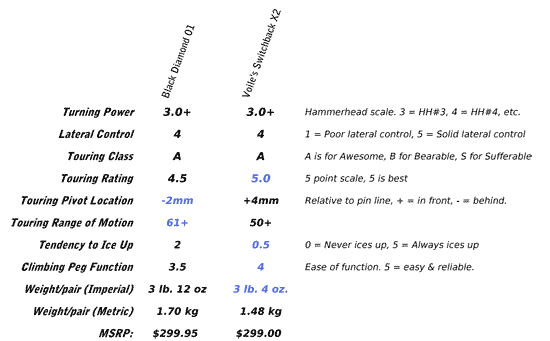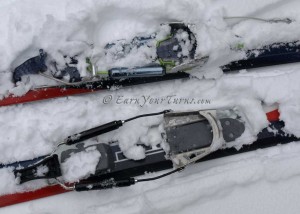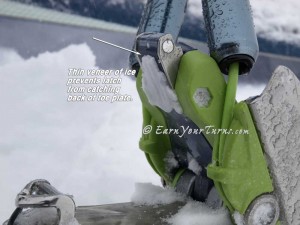Clouds were still spitting snow on the slopes around Tahoe and the trend has been for fewer and fewer customers as spring marches on toward summer, despite continuing to flirt with old man winter. The result was three to five inches of whipped cream on a smooth base of glazed corn. It felt sort of like dust on crust, except the edges of the BD Aspects easily sliced the glaze and held fast while the creamy top fell to the sides.
Conditions were excellent for “testing” the ski in soft, firm, and in-bounds crud while simultaneously comparing Black Diamond’s popular O1 telemark binding with Voile’s beefed up Switchback X2. The two were pretty equal which allowed me to notice the skis performance.The first impression was how big the shovel on the Aspects felt. With 40mm of sidecut the tips on these boards love to dig in and turn. Running straight isn’t a condition they abide by when they’re put on edge, but thanks to a smooth flex they have a good repertoire of turn radii, from short and sassy to big sweeping carves.
Since the high country was enveloped in a spring storm the humidity was high, which creates conditions where snow easily packs into ice, clogging up whatever it can. Which is where the two bindings parted ways as I headed out of bounds to rendezvous with a group from ASI.
In terms of basic uphill and downhill performance the two were indistinguishable. When I compared the cable resistance while lifting the heels of my boots without moving I could tell the O1 engaged a little quicker. However, even though Voile’s X2 didn’t equal the resistance of the O1’s with midstiff spring until about the 8-10 degree zone, it wasn’t that far behind. While actively skiing few spend enough time in the flat-to-five-degree range long enough to notice. The practical result is the two bindings felt identical, smoothly delivering plenty of power to carve through cream cheese, a few firm patches, or chunder, the snow flavor du jour.
On the uphill BD’s O1 still takes the prize for how simple the mode switch operates, at least going from locked toe to free-pivot. However, in terms of raw energy, the Switchback takes less energy — it’s just harder to locate since it is so easily obscured by snow. And when it came time to lock the toe, Switchback won that contest without even breaking a sweat. The O1 iced up two times out of three climbs, requiring a bit of fussing before I could lock the toe for ripping turns. Here on the wet coast when the O1 ices up it is usually because a thin veneer of snow sticks to the underside of the toe. It’s only 1-2 mm thick, but that’s enough to prevent the latch from catching the back of the toe plate. Once you know this, you just need to reach underneath and swipe it clean. It should also be noted that even though my lone O1 binding iced up, another telemarker in the group, Pete Guavin, editor of the Adventure Sports Journal, didn’t experience any icing at all with his pair of O1’s. Icing up can happen, but it is more rare than common with the O1.
The most obvious difference between the two bindings was the functionality of the climbing pegs. Both were easily lifted using the cornice shaped hook on the underside of the handle of my K2 Lock-Jaw™ ski poles. The BD climbing wire lifted easily, and snapped into place easily. By comparison, Voile’s heel peg lifted halfway with no resistance, then required a dedicated tug to finish lifting it all the way. But when it latched into vertical position, it did so with a much more retentive snap.
Could I tell the O1 was heavier than the X2 by about four ounces? Not without a scale.
Which would I recommend? That all depends on what you’re using already, and what you’d pair it with. I was driving BD Aspect skis with red Scarpa T2X’s. Even if I had a bigger boot either binding would work fine.
If I wanted more power than HH#3+, which is about what these two bindings are equivalent to, then you should consider the O1 with Ridstiff springs, or Axl. The fatter your skis, or the bigger your boots, the more I’d lean towards more power.
However, if want hassle free touring with more than enough power to drive a wide range of skis, you’d be hard pressed to beat the Switchback X2.




7 comments
3 pings
Skip to comment form
Cool, thanks Dostie- I like the comparison chart
Author
You’re seeing just a portion of the key elements I’ve been keeping track of for the past 6 years regarding tele bindings. For comparison, the NTN binding rates a 3 for its Touring Rating, and a range of 3 – 5 for Turning Power. As I review each binding more of these numbers will be shared. Naturally I encourage votes from users like yourself to confirm, deny, or debate my perspective. 😉
Thanks Craig. Not sure on the Voile, but the O1’s store nicely in that the heel-throw locks securely behind the heel riser when done skiing. That way the cable is not flopping all over the place when not in use. It also provides a cleaner profile when carrying skis on a pack. Little things help. 🙂
Author
The heel post and wire do the same thing with Voile’s heel post system. Like the O1, the key is getting the post location correct. I prefer the Voile simply because you can easily slide the heel post fore and aft after the holes are drilled. With BD’s O1, you better double check with your boots and a properly adjusted cable before you drill the holes for the heel post. But when properly positioned, they both allow the heel lever to be latched to the back of the post so it doesn’t flop around.
Just an observation as I’ve never skied the Hammerhead. Like you, I use the RidStiff O1 cartridges and can’t imagine a stiffer cable with a more rigid/powerful feel when its tweeked properly. Seems like the “turning power” should be higher @ 4-4.5. A stiffer boot (or not!) and a rocker ski changes everything. I don’t think the Aspect is rockered..? I like the variables in your comparison chart for telemark bindings.
Author
Valdez,
That scale represented using MidStiff springs since that was what I was actually comparing side-by-side. Agree that with RidStiff springs the rating is more like HH#4. That’s why I recommended it at the end for those who want more power.
If you had skied the Hammerhead, more importantly, if you had the opportunity to get half a dozen solid telemarkers to ski the Hammerhead side-by-side with the O1 you would probably conclude, as I did, that the O1 with rid stiff springs is ~ HH#4+. One tester thought the O1 was equal to HH#5, but everyone else said it was closer to HH#4. As to whether that plus makes it HH#4½ or not would depend on personal variables like your style and the stiffness of the boot used.
When I ran the tele binding test for Backcountry Magazine 3 years ago it was obvious after looking at the tester data that there are more powerful bindings than the O1 with RidStiff springs. Namely, HH#5 (which is equivalent to Axl#3).
Just a few comments on the 01 workhorse. I’m ski/ning the latest version with more holes than ever. The green binding matches my jacket which is not so good. And yes, it still gets ice built up under the toe plate.
One issue I had previously was the “wobble” that eventually develops after 100+ days. I think I cured that, not BD. I think they require the cables to be to tight. With their guidelines, even after I released the heel throw, my boot would be so stuck in the toe piece that I had to use brute force at times to dislodge my toe. Telemark binding have been sticky before, but not this bad.( I’m using the super stiffs.)
With the latest version I am not tightening it to specs and backing off what seem like about 8-10 1/2 twist on each cable side. The cables still seem stiff and my boot has no play in the toe. And its skis fine. I put a black mark on the cable as a gauge so I can watch for slippage.
Only time will tell if backing off on the recommended cable tension will eliminate the wobble issue at the pivot. More test to come (grin!)
[…] […]
[…] Related Posts: Comparing BD’s O1 to Voile’s Switchback X2 […]
[…] Field comparison of Voile Switchback X2 vs BD’s O1 […]